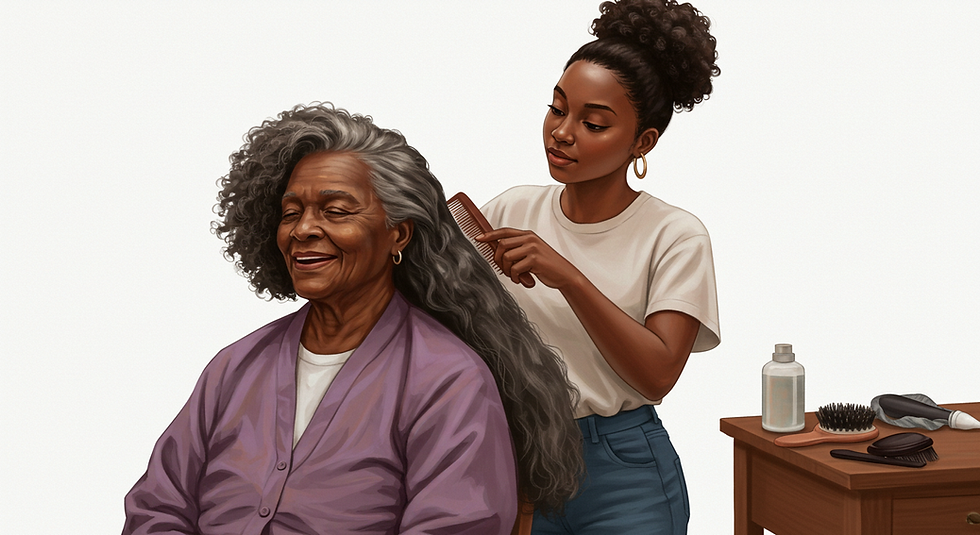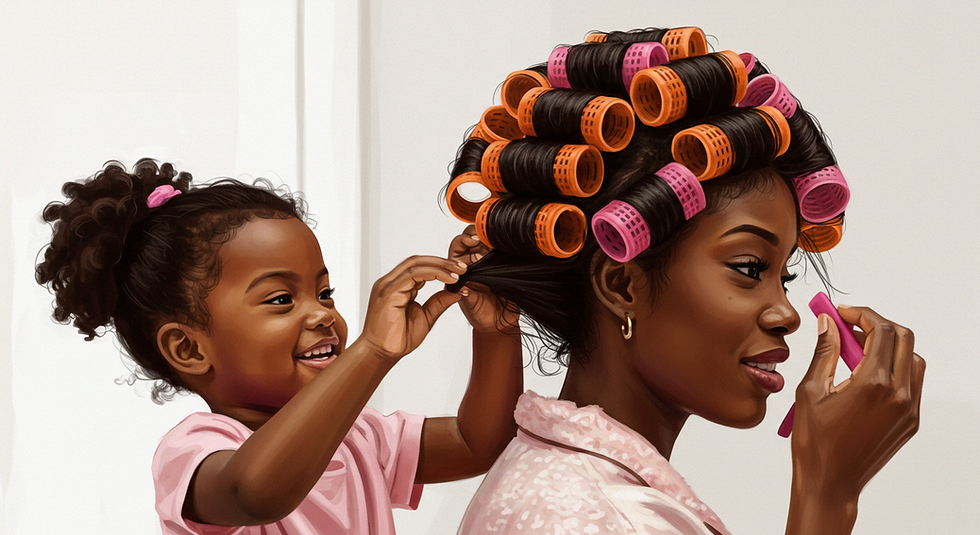What is the least damaging hairstyle for black women? Part 2
- The Editor
- Aug 14
- 6 min read
Updated: 3 days ago

The quest for "least damaging" isn't about sacrificing style, but about making informed decisions that promote long-term hair and scalp health.
Why Gentleness is Key
To make truly empowering choices, we must revisit the inherent characteristics of Afro-textured hair. It's not just hair; it's a marvel of natural design. Its distinct elliptical shape, coupled with multiple twists and turns along the shaft, gives it its exquisite curl pattern. However, this very structure also contributes to its increased fragility, making it more susceptible to breakage and knots compared to straighter hair types.
Studies show that African hair has lower tensile strength and lower moisture content, which means it can reach its breaking point earlier than other hair types. Furthermore, our hair grows at a slower rate and has a lower density than Caucasian or Asian hair, averaging 280 µm/day and 161 hairs/cm² respectively.
This detailed understanding is crucial because it informs why certain styling practices can be particularly damaging. Afro-textured hair demands a bespoke approach that respects its delicate nature, moving away from practices that have historically caused trauma due to a lack of knowledge or societal pressure. Our goal is to shift the narrative from struggle to celebration, offering insights that enable you to maintain vibrant, healthy hair.
Damaging Practices: What to Avoid and Why
For generations, Black women have been influenced by beauty standards that often clash with the natural state of their hair. The result has unfortunately been widespread use of practices that, while achieving a desired look, contribute to significant hair and scalp disorders.
The Harsh Realities of Chemical Relaxers: These powerful chemical straighteners, predominantly containing highly alkaline sodium hydroxide (often referred to as lye), function by irreversibly breaking the disulfide bonds within the hair's protein structure. This chemical alteration makes the hair straight but also inherently weaker and more susceptible to damage. The application process itself often leads to scalp lesions and burns, which can serve as entry points for the toxic chemicals, exposing users to a variety of harmful substances. Beyond immediate concerns, long-term use of relaxers has been significantly associated with an increased risk of uterine fibroids. Emerging research, while needing further confirmation, also indicates a potential link between the use of chemical hair straighteners and an increased risk of breast cancer. What’s particularly alarming is that hair damage from relaxers can persist for an extended period, with some studies suggesting it may remain active for 2-4 years even after discontinuing use, as all chemically altered hair needs to be replaced by new growth.
The Double-Edged Sword of Thermal Styling: Tools like hot combs and flat irons temporarily straighten hair by rearranging hydrogen bonds, but they do so using extremely high temperatures, often ranging from 300 to 500°F (149 to 260°C). Frequent application of such intense heat can lead to severe hair damage, including acquired trichorrhexis nodosa (recurrent hair breakage) and "bubble hair" (visible bubbles within the hair shaft caused by water boiling inside). Many women repeatedly press their hair at home every few days to maintain the straightened look, which significantly exacerbates hair damage and increases the risk of thermal burns to the scalp, ears, and neck. This constant exposure to high heat compromises the hair's integrity, leading to chronic dryness and brittleness.
The Tension Trap of Tight Styles and Extensions: Traction alopecia (TA) is a prevalent concern in the Black community, directly attributable to persistent pulling or tension on the hair follicles. Common culprits include excessively tight ponytails, braids, cornrows, and the use of hair extensions or weaves that are too tight or worn for extended durations. The prevalence of TA among Black women is significant, estimated at around 32%. Hair weaves, for instance, typically involve tightly cornrowing the natural hair along the scalp, then sewing, braiding, clipping, or gluing hair extensions onto these cornrows. This process can exert immense stress on the hair follicles. Furthermore, synthetic hair extensions can cause irritant contact dermatitis, and glues used for extensions can lead to allergic reactions. It is particularly crucial to note that pulling already relaxed (and thus weakened) hair into tight styles significantly increases the risk of traction alopecia.
The Pillars of Healthy Hair Care: Embracing Low-Damage Approaches
The positive shift towards embracing natural hair among Black women is a powerful movement rooted in self-acceptance and health consciousness, not merely a political statement. This understanding forms the foundation for what we consider the least damaging approaches to hair care.
Prioritising Natural Hair: The most truthful and reassuring message is that your natural hair, in its unaltered state, inherently has the fewest adverse associations with hair and scalp disorders. This doesn’t mean natural hair is indestructible, but it does mean that by avoiding harsh chemicals and excessive heat, you eliminate the primary sources of damage that lead to conditions like acquired trichorrhexis nodosa, chemical alopecia, and reduce the risk factors for scarring alopecias.
Mastering Loose Protective Styles: Protective styles like braids, twists, and dreadlocks are fantastic for minimising daily manipulation and allowing your hair to rest, promoting length retention and reducing breakage. The absolute golden rule here is tension control.
Braids and Cornrows: Ensure they are not pulled tightly at the roots; you should be able to comfortably touch your scalp between the braids. Proper spacing between braids is crucial, allowing for adequate scalp cleansing. Washing your scalp and hair every 1-2 weeks, even with braids in, is essential for preventing scalp conditions like seborrheic dermatitis. Use a mild shampoo and allow hair to air dry naturally. To avoid breakage, be patient during removal and never cut your natural hair when taking out extensions.
Twists and Dreadlocks: These are excellent low-maintenance options that don't require chemical alterations, allowing for significant length retention over time.
Wigs and Weaves: When used correctly, wigs and weaves can be fantastic protective options, especially for covering natural hair and reducing manipulation, particularly if your hair is cornrowed underneath. To minimise friction and potential breakage, wear a silk or satin cap underneath your wig. For weaves, opt for loosely sewn-in extensions and avoid excessive length, as longer extensions can increase tension on your natural hair. Limit the duration of these styles, aiming for no more than 3-4 weeks for extensions before giving your hair a break and alternating to a natural style.
Gentle Handling and Minimal Manipulation: Given the inherent fragility of Afro-textured hair, gentle handling is paramount. Avoid aggressive combing or brushing, especially when wet, as wet hair is more vulnerable to breakage. Use wide-tooth combs and your fingers for detangling, starting from the ends and working your way up.
Consistent Cleansing and Deep Moisturising: Regular scalp cleansing, ideally weekly or bi-weekly, is vital to prevent product buildup and address concerns like seborrheic dermatitis. While hair oils can provide lubrication and reduce abrasive damage from grooming, be mindful that excessive use, particularly if your curls are tight and impede sebum flow, can increase the risk of seborrheic dermatitis. Counteracting the natural dryness of Afro-textured hair requires consistent deep conditioning and moisturising.
Strategic Chemical and Colouring Use: If you choose to use chemical relaxers or colours, it's crucial to seek experienced professionals. Space out these treatments, ideally by days to weeks, to allow your hair to recover and minimise cumulative damage. Always perform patch tests for allergic reactions, especially with synthetic hair or dyes.
Your hair journey is a testament to your strength and beauty. By prioritizing informed, gentle practices and embracing your hair's unique characteristics, you are not only choosing the least damaging path but also cultivating a deeper relationship with your authentic self. This is the essence of Unwild: empowering you to make choices that celebrate your hair, your health, and your unwavering confidence.
Read More:
Selected References
Asbeck, S., Riley-Prescott, C., Glaser, E. & Tosti, A. (2022) Afro-Ethnic Hairstyling Trends, Risks, and Recommendations. Cosmetics, 9:17.
Johnson, T. A. & Bankhead, T. (2014) Hair It Is: Examining the Experiences of Black Women with Natural Hair. Open Journal of Social Sciences, 2, 86–100.
Mbussuh Nzeng, L. F., Nguefack-Tsague, G., Kotto, R., Tounouga, D. N., Sigha, O. B., Nkoro, G. A., Nida, M. & Kouotou, E. A. (2023) Hair Care and Epidemiological-Clinical Profile of Traction Alopecia Among Women in Hair Salons in Yaoundé, Cameroon. Skin Health and Disease, 3.
Molamodi, K., Fajuyigbe, D., Sewraj, P., Gichuri, J., Sijako, B., Galliano, A. & Laurent, A. (2021) Quantifying the impact of braiding and combing on the integrity of natural African hair. International Journal of Cosmetic Science, 43, 321–331.
Wright, D. R., Gathers, R., Kapke, A., Johnson, D. & Joseph, C. L. M. (2011) Hair care practices and their association with scalp and hair disorders in African American girls. Journal of the American Academy of Dermatology, 64, 253–262.


